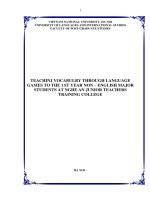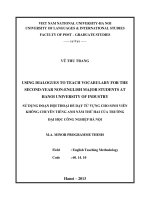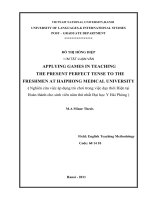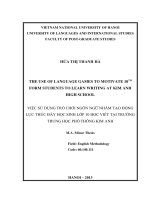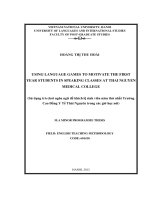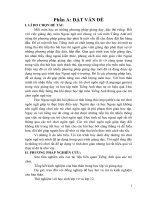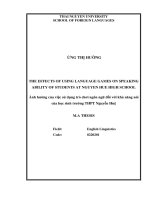Nghiên cứu việc sử dụng trò chơi ngôn ngữ để dạy từ vựng cho sinh viên khối không chuyên năm thứ nhất ở trường CĐSP Nghệ An
Bạn đang xem bản rút gọn của tài liệu. Xem và tải ngay bản đầy đủ của tài liệu tại đây (627.74 KB, 59 trang )
1
VIETNAM NATIONAL UNIVERSITY, HA NOI
UNIVERSITY OF LANGUAGES AND INTERNATIONAL STUDIES
FACULTY OF POST-GRADUATE STUDIES
TEACHINJ VOCABULRY THROUGH LANGUAGE
GAMES TO THE 1
ST YEAR NON – ENGLISH MAJOR
STUDENTS AT NGHE AN JUNIOR TEACHERS
TRAINING COLLEGE
HA NOI -
5
TABLE OF CONTENTS
Page
Declaration……………………………………………………………………
………i
Acknowledgements……………………………………………………………
…… ii
Abstract………………………………………………………………………
……….iii
Table of
contents…………………………………………………………………… iv
Appendix………………………………………………………………………
…… vi
List of tables and
figures…………………………………………………………… vii
Part A: Introduction……………………………………………………… 1
1.1. Rationale………………………………………………………………
………1
1.2. The aims of the
study………………………………………………………….2
1.3. Research
questions…………………………………………………………….2
1.4. Scope of the
study…………………………………………………… 3
1.5. Methods of the
study………………………………………………………… 3
6
1.6. Design of the
study…………………………………………………………….3
Part B:
Development…………………………………………………………4
Chapter 1: theoretical background……………………………… 4
I.1. Overview of teaching and learning
vocabulary……………………………… 4
I.1.1. The roles of vocabulary in language
learning………………………………… 4
I.1.2. Principles of the teaching
vocabulary………………………………………… 5
. Criteria for selection of
vocabulary……………………………………………………… 5
. What to teach and
learn…………………………………………………… 5
. How to teach and
learn? 7
I.1.3. Techniques of vocabulary teaching currently used
………………………… 9
I.2. Overview of language games
……………………………………………… 11
I.2.1. Definition of language
games………………………………………………… .11
I.2.2. Types of language
game…………………………………………………………12
7
I.2.3. Roles of language games in language
teaching…………………………………12
I.3. Overview of language games in vocabulary
teaching…………………… 13
I.3.1.Types of vocabulary
games………………………………………………………13
. Types of vocabulary games for presenting new
words………………………………… 13
. Types of vocabulary games for revising
vocabulary…………………………………….14
I.3.2. Roles of vocabulary games in teaching
vocabulary…………………………….14
1.3.3 Related
studies……………………………………………………………… 15
1.3.4 Fitness of the
study……………………………………………………………16
Chapter 2: Methodology………………………………………………….17
II.1. Background to the
study………………………………………………………17
II.1.1.
Hypothesis…………………………………………………………
17
II.1.2. Subjects of the study and the
textbook……………………………………… 17
II.2. Data
collection………………………………………………………………… 18
8
II.2.1. The data collection
instrument…………………………………………………18
II.2.2. Methods and Procedures of data
collection……………………………………19
Chapter 3: data analysis and discussion………………………… 20
III.1. Data
analysis………………………………………………………………… 20
III.2.
Discussion……………………………………………………………………
30
III.2.1
Effectiveness…………………………………………………………………
30
III.2.2.
Challenges…………………………………………………………………….3
2
Chapter 4: Suggestions on using vocabulary games to teach vocabulary
effectively
IV.1 When to use a vocabulary
game……………………………………………….34
IV.2 How to organize a vocabulary games
……………………………………… 34
IV.3 How to conduct a vocabulary game in
class………………………………….35
Part C:
Conclusion………………………………………………………… 36
9
1. Summary……………………………………………………………………
…… 36
2. Limitations and recommendations for further
study…………………………… 36
References…………………………………………………………………
…37
10
Appendixes
Appendix 1: Survey questionnaire for teachers
Appendix 2: Survey questionnaire for students
Appendix 3: Inteview for teachers
Appendix 4: Inteview for teachers
Appendix 5: Sample games
List of tables and figures
Table 1: Data collected from survey questionnaire for teachers
Table 2: Data collected from survey questionnaire for students
11
Figure 1: Situation of using vocabulary games in teaching and learning
vocabulary
Figure 2: Attitudes towards vocabulary games in teaching and learning
vocabulary
Figure 3: Purposes of using vocabulary games
Figure 4: Kinds of vocabulary games used in teaching and learning
vocabulary
Figure 5: Benefits and Difficulties when using vocabulary games in class
Figure 6: Students‟ participation in vocabulary games
Figure 7 Students‟ feeling after playing vocabulary games
Figure 8: Students‟ evaluation of effectiveness of vocabulary games towards their vocabulary
learning
Figure 9: Students‟ expectations towards a useful vocabulary game
Figure 10: Actual use of vocabulary games in class.
Part A: Introduction
1.1. Rationale
Nowadays, English has become popular all over the world, and in Viet nam, English also
plays a very important role in every field of life. This makes English become the common
language of communication. Thus, the demands for using English as a means of
communication make the English teaching and learning more and more necessary.
Different people study English for different purposes. People learn it for communicating
with foreigners, for using English as a means which enables them to understand more
about English people and country, or for promoting their positions during their lives, etc.
However, the fact which I have recognized at my college is that non- English major
students are not eager in studying English because of some reasons. First of all, non-
12
English major teachers still apply traditional method into teaching English. They always
teach students the vocabulary, grammar structures of English before practicing it. In
English lessons, teachers often explain the rules of language by
Vietnamese and then ask students to reproduce them. Teachers often focus on the aspects
of language such as grammar, phonetic and vocabulary so students can only learn what
their teacher has, they become passively involved in lessons and bored with English
lessons. Moreover, many teachers do not want to make changes in their teaching process
since they will feel nervous and embarrassed when coping with difficulties to which they
can not find answers immediately. Besides, for non- English major students, English is not
their compulsory subject at college so they learn it just for passing exams which they sit for
at the end of each semester rather than trying to use English for communication. Many of
students are lack of effort and desire in learning English; they find English more difficult
and less interesting than other subjects. Classes of non- major students are often crowded
with various levels of knowledge so it is rather hard for teacher to apply new methods of
teaching for improving students‟ knowledge of English and get these learners involved in
learning English.
Among many activities in classroom such as pair work, group work, role- play,
singing songs, games, etc…games have been shown to be a means which has lots of
advantages in motivating students in learning the target language by many researchers and
educationists. Richard (1988) states that “Games can lower anxiety, thus making the
acquisition of input more likely” (p.147). “They are highly motivating and entertaining,
and they can give shy students more opportunities to express their opinions and feelings”
(Hansen, 1994, p.118).
In addition, vocabulary also plays an important role during teaching and learning a
foreign language. It is difficult for students to enhance other skills such as listening,
speaking, reading and writing, if they are lack of vocabulary knowledge. Nation and
Warring (2004) points out that “Vocabulary knowledge is always a prerequisite to the
performance of language skills”. (p.1)
The above reasons lead the researcher to the study “Teaching vocabulary through games to
1
st
year- non English majors students at Nghe An Junior Teachers Training College”.
1.2 Aims of the study
For the reasons mentioned above, the study aimed:
13
Investigating non- English major teachers and students‟ feeling and attitude
towards using language games in teaching and learning English Vocabulary.
- Finding out effectiveness and challenges of using games in teaching and learning
English Vocabulary to 1
st
year- non English major students at Nghe An Junior Teachers
Training College”.
- Providing non- English major teachers with in- depth understanding about games
and the ways of conducting games in classroom to make decisions when and how they
should organize games to keep their learners interested in learning English vocabulary.
1.3. Research questions
To achieve the above- mentioned aims, the following research questions were proposed:
1. What are teachers and students‟ perspectives towards using language games in
teaching and learning English Vocabulary?
2. What are teachers‟ current ways of using vocabulary games in the lessons?
1.4. Scope of the study
The study focuses specifically on using language games in teaching vocabulary to
1
st
year- non English majors students at Nghe An Junior Teachers Training College.
Therefore, the study limits itself to teaching and learning vocabulary only. The subjects of
the study are 80 non- English majors from three classes: K31 Chemistry - Biology, K7A
Information- Technology and K16B of The Children Teachers Training Department who
are studying “New- Headway – Elementary” and 8 non- English major teachers at Nghe
An Junior Teachers Training College.
1.5. Methods of the study
In the process of carrying out this study, the survey questionnaire is used to collect data for
the study. Two written questionnaires are administered to the subjects. One is for teachers
and the other is for students. The questions focus on these following points: Teachers and
students‟ perspectives towards using language games in teaching and learning vocabulary;
teachers‟ the current ways of using games in teaching vocabulary. Besides, the
observations and interviews are also applied in order to clarify and test the validity of
information about using games in teaching vocabulary.
1.6. Design of the study
The study id divided into three main parts:
14
Part A is an introduction of the study including the rationale, the aims, the research
questions, the scope, the methods and the design of the study.
Part B is the development which consists of four chapters. Chapter I presents the
theoretical background of the study basing on the points: Overview of teaching and
learning vocabulary; overview of language games; overview of language games in
vocabulary teaching. Chapter II deals with the methodology including hypothesis, Subjects
of the study, the data collection instrument, methods and procedures of data collection.
Chapter III is the analysis of the data and the discussion about the effectiveness and
challenges of using language games in vocabulary teaching. Chapter IV is the suggestions
on using vocabulary games to teach students vocabulary more effectively.
Part C is the conclusion which includes the summary of the study, limitations of the
research and suggestions for further study.
15
Part B: development
Chapter 1: theoretical background
In this chapter, the important roles of vocabulary as well as vocabulary teaching
principles and techniques in foreign language teaching and learning are discussed. In
addition, an overview of language games including definition, roles and types of games,
etc. in vocabulary teaching are also presented and commented upon.
I.1 Overview of teaching and learning vocabulary
I.1.1. The roles of vocabulary in language learning and teaching
In order to communicate effectively in foreign language, learners not only own a
number of grammar structures but also master an adequate knowledge of vocabulary so
that they can understand the around world and express by themselves more clearly and
appropriately in a wide range of situations.
Many studies have proved the importance of vocabulary in language teaching and
learning. Wilkins (1972) stated that “Without grammar, very little can be conveyed,
without vocabulary nothing conveyed” (p.11). Piles and Alges, (1970) emphasizes that
“when most of us think about language, we think first about words”. (p.96). It means that
vocabulary is the central of language as words with their own characteristics enables
people not only communicate with one another but also create lots of different kinds of
discourse. Nation and Warring (2004) also states that “Vocabulary knowledge enables
language use, language use enables the increase of vocabulary knowledge, knowledge of
the world enables the increase of vocabulary knowledge and language use and so on” (p.1).
Dublin and Olshtain (1986) refer to the fact that “possessing a good vocabulary stock is
what enables many learners to use their knowledge effectively and in ways which fit their
specific needs” (pp. 111-112).
Researchers have also shown that most learners‟ difficulties are due to lack of
vocabulary. According to Nation (1990) “learners felt that many of their difficulties in both
receptive and productive language use result from an inadequate vocabulary”. (p.2).
Besides, Nagy (1989) asserts “lack of adequate vocabulary knowledge is already an
obvious and serous obstacle for many students” (p.1).
16
From the above findings, it can be concluded that vocabulary plays a prominent
role in foreign language learning and teaching
I.1.2 Principles of teaching and learning vocabulary
As shown above that vocabulary is an essential element in learning a foreign
language. It demands teachers to follow strictly the vocabulary learning and teaching
principles in order that they can help learners acquire the second language lexicon more
easily.
I.1.2.1 Criteria for selection of vocabulary
It is obvious that vocabulary has an essential role in teaching and learning a foreign
language. Gairn and Redman (1986) state that three main criteria for selecting of
vocabulary are: “frequency, students‟ need and level, cultural factor and expediency”
(p.57-63). The most frequently used word should be chosen first. Then, it is important for
teachers to select what vocabulary items which are appropriate to the learners‟ level and
meet to the students‟ needs, for example, vocabulary used for English as a subject in the
curriculum is different from English for specific purposes … The third thing is cultural
factor. People from different countries have different ways of using words for expressing
their ideas in the daily life in the second language. The last thing is the expediency because
the classroom is an environment which requires specific types of vocabulary for classroom
activity instructions.
Richard Frost (2001) states that “…your students will not need to produce every
word they learn, some they will just need to recognize. Selecting what to teach, based on
frequency and usefulness to the need of your particular students is therefore essential.” (p. 1).
I.1.2.2 What to teach and learn?
Nation (1990) stated that “Knowing a word involves not only knowing its
meaning(s) but also knowing its forms and its usage” (p.3). Therefore, to teach and to learn
vocabulary well, both teachers and students must master the following factors.
I.1.2.2.1 Forms
When encountering a new for the first time, students often perceive its
pronunciation and spelling forms. Since the relation between how a word is written and
how it is pronounced is rather vague, there should be the phonemic script of the word so
that students can pronounce the word correctly. Besides, for further understanding of a
word, the teachers and students need to know: the grammatical behavior of the word, the
17
collocation of the word and the associations of the word. It is very important for teachers to
provide students with an unpredictable change of form in certain grammatical contexts or
some idiosyncratic ways of connecting with other words in sentences at the same time as
teaching the base form. For example, when teaching the verb, teachers need to introduce
the present form, the past form, transitive or intransitive verb, etc. Gains and Redman
(1999) classified three main forms of word building: affixation (the process of adding
prefixes and suffixes to the base form); compounding (the formation of words from two or
more separated words) and conversion (process by which an item may be used in different
parts of speech) (p. 47). Collocation is the way in which words are combined together, and
it sounds “right” or “wrong” in a given context. In another way, collocation is defined as a
sequence of words or term which co- occur more often than would be expected by chance
(Wikipedia, the free encyclopedia). For example, when introducing words like “decision”
or “conclusion”, we must use verb “make” before these words: “make a decision” or
“make a conclusion” as well as in expressions like “by the way, on the other hand…” we
can not omit any words or add other words into these phrases.
I.1.2.2.2 Meaning
Teaching the meaning is another important aspect of vocabulary teaching. This
aspect consists of denotation, polisemy and connotation.
The meaning of a word is primarily what it refers to in the real world, its denotation; this
sort of this definition is often given in a dictionary.
According to Wikipedia, the free encyclopedia: “denotation is the surface of literal
meaning encoded to a signifier, and the definition most likely to appear in a dictionary”.
For example, „snake‟ denotes a kind of animal, legless, having a long, tapering, cylindrical
body and found in most tropical and temperate regions. In fact, the words can contain
many different meanings; one word in English often has more than one denotation, which
is polisemy. On the contrary, “connotation” refers to the association or positive or negative
feeling it evokes, which may or may not be indicated in a dictionary definition.
“Connotation is a subjective cultural and or emotional coloration in addition to the explicit
or denotative meaning of any specific word or phrase in a language” (Wikipedia, the free
encyclopedia). This means that readers can infer other meanings from the context based on
words.
18
There are various relationships between the meaning of one item and the meanings
of others. They are: synonyms, antonyms, hyponyms, co-hyponyms or co-ordinates,
superordinate, homophones, etc. Synonyms are items that mean the same, or nearly the
same, for example, „clever, smart, bright‟ may serve as synonyms of „intelligent‟.
Antonyms are items that mean the opposite e.g. „tall‟ is antonym of „short. Hyponyms are
items that serve as specific example of a general concepts; „dog, lion, mouse‟ are
hyponyms of animal. Co-hyponyms or co-ordinates are items that are “the same kind of
thing”; „red, blue, green and brown are co-ordinates. Superordinates are general concepts
that “cover” specific items; „animal‟ is the superordinate of „dog, lion and mouse‟.
Homophones are words that have the same pronounce but different spellings and meanings
e.g. „eye- my; hair- there‟.
I.1.2.2.3 Usage
It is obvious that the words we use are often governed by the style and register we
are in. Words are not only restricted geography and socially but also restricted by styles of
speaking or writing. The vocabulary of written English is greatly different from the
vocabulary of spoken English. Spoken language is the language of face to face
conversation, therefore speakers can use a variety of communication tools such as gestures,
tone of voice, facial expression while in writing, writers have to select the words precisely
for richer usage of vocabulary. Besides, the meaning of a word can be changed as it is used
in different contexts, for example, the meaning for the word „gave‟ is changed in following
contexts: „He gave his wife five dollars‟; “He gave his wife a kiss‟ or „the doctor gave the
patient an injection‟… So, in teaching vocabulary, teachers should create more
opportunities for students to use vocabulary items effectively.
I.1.2.3 How to teach and learn vocabulary
I.1.2.3.1 Teaching spoken form first then written form
James Cook (2005) states that: “children acquire their first language in spoken form
before written”. (p.425). John Haycraft (1978) also emphasizes that “whenever possible,
teach the words in spoken form first, and only when your students can pronounce them
well, introduce the written form” (p. 47). There is no clear relation between how a word is
written and how it is pronounced. If teachers provide students with the written form first,
their students will become familiar with these forms, consequently they will make lots of
19
mistakes in reading as well as in speaking. Thus, a foreign language in general and
vocabulary in particular should be taught in spoken form first then written form.
I.1.2.3.2 Putting new words into context and getting students to practice
In the acquisition of vocabulary, second language learners often encounter
unfamiliar words and they are always in the need to understand more about unfamiliar
meanings of words. To overcome these difficulties, unknown words should be put into
contexts, as contexts help learners to work out the meaning of words from the around
world for themselves. Nagy (1997) also points out that “to infer the meaning of any
particular words encountered in context, it is helpful to know the meanings of the words
around it” (p.79). Haycraft (1978) expresses that “if the word occurs in a text or passage,
the meaning can often be deduced when the other words in the sentence are already
known” (p.47). Besides, the context also enables learners to select the most appropriate
sense of words and know how to use them in communicating with other people, as
“communication is a process, students must be able to apply the knowledge of target
language (forms, meanings and functions) in negotiating meaning. It is through the
interaction between speaker and listener that meaning becomes clear” (Larsen- Freeman,
1986, p.123). Moreover, students should practice vocabulary regularly, at any time of daily
life and in any situations inside or outside the class so that they can improve their
knowledge of vocabulary.
I.1.2.3.3 Presenting vocabulary in a memorable way
Hubbard (1983) states that “Teachers must make sure students have understood the
new words, which will be remembered better if introduced in a “memorable way”. (p.50)
Teachers should employ various techniques or combine them for presenting words in an
attractive way, for example, giving concise definition, detailed description, illustration,
demonstration, contexts, etc. and then put to regular practice to help students retain new
words longer and better.
I.1.2.3.4 Checking and revising vocabulary frequently
The ability of people‟s retaining information divided into two stages: short- term
memory and long- term memory. According to Gains and Redman (1986) “unlike short-
term memory which is limited in capacity, long- term memory is seemingly inexhaustible
and can accommodate any amount of new information” (p.86).
20
Teachers should create more meaningful vocabulary activities to offer students
more chances of practicing and revising so that students can retain more new words in
long-term memory since “items which occur most frequently are also easily recognized
and retrieved” and “repetition gives the students the opportunity to manipulate the oral and
written forms of language items” (Gains and Redman, 1986, pp. 88-89).
I.1.2.3.5 Learning groups of words as units
For people beginning to learn a language, a way of quickly developing fluency is
learning groups of words as units. According to Moras (2001) “vocabulary is not stored
only as individual words, but also as parts of phrases and larger chunks (include
collocations, fixed and semi- fixed expressions and idioms) and occupy a crucial role in
facilitating language production being the key to fluency”(p.5 ). And “learning vocabulary
is learning how words relate to external reality and how they relate to one another”
(Wilkin, 1972, p.133). On the other hand, learning individual words will waste students
much time and effort in expressing themselves. As a result, teachers should give students
more opportunities to identify, organize and record chunks, even in the initial stage of
foreign language learning process.
I.1.3. Techniques of vocabulary teaching
I.1.3.1 Techniques for presenting vocabulary
For drawing students‟ attention to new vocabulary items, the teachers should adopt a
large number of techniques such as verbal or visual techniques (flashcards, photographs
and pictures, wall charts, blackboard drawings, word pictures, regalia, mime and gesture,
etc.) and other many techniques such as translation, matching activities, story- writing, fill
in the blank, etc. or combine all techniques above.
I.1.3.1.1 Visual techniques
According to Gains and Redman (1986): “Visuals are an extremely useful
framework for storage of lexis, and they can be used to highlight the relationships between
items” (p.96).
This technique consists of using pictures, regalia, mime, flashcards, etc. following
Gains and Redman‟s classification (1986, pp. 103-113).
Using pictures:
This technique is the most useful „aid‟ for teaching concrete items of vocabulary
21
such as clothes, means of transport, etc. and certain areas such as places, jobs, descriptions.
Pictures can be used in explaining the meaning of words in various ways by using
blackboard drawings, wall pictures and photographs from magazines or wall charts.
Using regalia: This is the way of using real objects to show the meaning of words. By
pointing at real objects, the teacher will make the explanation of the meaning of words
more clearly to their students. Teachers can use anything in the classroom or brought into
the class: a chair, hats, cups, etc. As teaching vocabulary with real objects, teachers only
need to point to these things and ask learners describe, make sentences, repeat words.
Using mime: This technique is often used to show the meaning of words through actions
and facial expressions. Teachers can use mime for explanation action verbs (jumping,
walking, write, etc.) or feeling and status adjectives (happy, sad, ill, etc.). The technique is
suitable for learners who enjoy acting and moving.
In general, visual techniques are attractive to get learners involved to the lesson. It is an
effective way for presenting concrete words for low level beginning learners.
I.1.3.1.2 Showing the meaning of words in context
This is a useful technique for abstract words (happiness, love, difficulties, etc.).
Teachers may give learners explanation of words by using examples, sentences or
situations. They are very helpful for learners to guess the meaning of words from
surrounding words.
Thus, the teacher should create contexts in which the word is used for helping
students to clarify the meaning further.
I.1.3.1.3 Verbal techniques
This is also an important technique in presenting vocabulary. For students who have
some knowledge of English, verbal techniques should be employed. These techniques
consist of using definition, illustrative situation, descriptions, synonyms and antonyms or
translation, etc. Definition sometimes causes learners difficulties since they may contain
words which learners do not know. Synonyms/ antonyms of the new words should be used
only when they are already known to learners. Translation can be considered the simplest
and clearest way of presenting new words. However, learners will not able to understand
the practical aspect of the words, if teachers only use translation. Teachers should combine
this technique with other techniques for being more successful in presenting vocabulary.
22
I.1.3.2 Techniques for checking/ revising vocabulary
After the stage of presenting vocabulary, the stage of consolidation is also
important. In this stage, the teacher must apply techniques which are useful for retaining
new words better and longer since new words will fade away day by day if they are not
consolidated or revised regularly. Bermheden (2002, p.8) states that “students need at least
three exercises on all new words to stand a chance of incorporating them into their store of
active vocabulary, and that should be the ultimate goal”. Teachers can employ a variety of
techniques for vocabulary consolidation and revision such as: giving a definition of a given
item, using multiple choice or gap filling exercises, matching synonyms or antonyms, etc.
Uberman (1988) points out that “Teachers can use many techniques for vocabulary
consolidation and revision: graphs, grids, multiple choice and gap filling exercises will
active the vocabulary… lists of synonyms or antonyms to be matched, sentences to be
paraphrased…” (p. 9). She adds that: “Visual aids can be of great help with revision.
Pictures, photographs, or drawing can facilitate the consolidation of both individual words
as well as idioms, phrases and structures”.
1.2. Overview of language games
1.2.1. Definition of language games
Teachers often organize games in language teaching, however, most of them are
confused as being asked questions such as “What is a game or what are differences
between games and language games?”.
Many researchers have done work in this area and have made their own definitions
of games. According to Hadfield (1987), “a game is an activity with rules, a goal and an
element of fun”. (p. 4). And Rixon (1983) has similar idea of games: “a game consists of
play governed by rules” (p.3). Most of these definitions share the common idea that a game
includes three main points. They are: a goal, a set of rules governed in a games and
players. Language games are games used in language classes. The main objectives of
language games are developing students‟ language skills and enlarge their knowledge of
language. Lewis and Benson (1999) explain this in more detail: “What differentiates
language games from other activities in the EFL classroom is presence of a visible set of
23
rules which guide the children’s actions, and an element of strategy- children must
successfully apply their language (and other) skills” (p.5).
1.2.2 Types of language games
For different objectives of language teaching, educators and researchers have
divided language games into different categories in various ways.
1.2.2.1 Language practice games
Language practice games can be defined as games for practicing language. Rixon
(1988) states that these games depend on players producing correct language or
demonstrating that they have interpreted a particular piece of language correctly (p. 22).
This kind of games is useful for primary level. They help correct and develop linguistic
elements, which are very important for children before practicing communicative skills.
Games for this sort are: Structure games, vocabulary games, spelling games, pronunciation
games, memory numbers, picture filling/ drawing games:
1.2.2.2 Communicative language teaching games
Communicative language teaching games are games aiming to develop general
communicative skills: Listening, speaking, reading, writing. In other word, the children are
given a non- linguistic task to complete and their success will depend on their ability to
carry out instructions, directions, descriptions, etc. Communicative language teaching
games can be divided into five categories according to the skills in the language learning:
Listen and do games, read and do games, games and writing, games and speaking,
integrating skills games (Lee, 1979).
1.2.3.Roles of language games in language teaching
For being more successful with teaching a foreign language, teachers should employ
different types of methods and techniques. Games are one kind of activity that contains lots
of advantages. Hadfield (1987) has stated that “Games should be regarded as an integral
part of language syllabus. They provide, in many cases, as much concentrated practice as
a traditional drill and more importantly, they provide an opportunity for real
communication, and thus constitute a bridge between the classroom and the real world”
(p.5). For the games‟ benefits, Wright (1992, p.1) says that: “Games also help the teacher
to create contexts in which the language is used and meaningful. The learners want to take
part …must understand … and must speak to express their own point of view… ”. Hansen
24
(1994) states that: “Thanks to games, shy language learners will have more chances to
speak and show their feeling and opinions in English as much as they can”(p.118).
Richard- Amato (1988) has a similar idea “Games can lower anxiety, thus making the
acquisition of input more likely” (p.147) “They are highly motivating and entertaining, and
they can give shy students more opportunity to express their opinions and feelings
(Hansen, 1994, p.118). With relaxed atmosphere created by games, learners will remember
things faster and better. During playing games, learners are easy to learn new words or new
structures since they do not feel to be forced by their teachers. And Carrier (1985)
assumes: “games provide quite extensive opportunities of language practice for both
general and specific language skills and so they should be seem as an integral part of a
teaching program” ( p.6). Aydan Ersoz (2000, p.12) also affirms that: “Games are highly
motivating because they are amusing and interesting. They can be used to give practice in
all language skills and be used to practice many types of communication”.
1.3 Overview of language games in vocabulary teaching
Many researchers have shown in their studies that games contains a lot of
advantages and have been considered as a useful tool for language teaching in general and
for teaching vocabulary in particular. According to Andrew Wright (2006): “Games help
the teacher to create contexts in which the language is useful and meaningful…. Games
provide one way of helping the learners to experience language rather than merely study it”
(p.2). “Games are highly motivating since they are amusing and at the same time
challenging” (Aydan Eroz, 2000, p.1). In the field of teaching vocabulary, Ghada Sari
states that “games bring in relaxation and fun for students, thus help them learn and retain
new words more easily” (p.1). Haycraft (1978) suggests that: “there are large varieties of
word games that are useful for practicing and revising vocabulary after it has been
introduced” (p.50). Thus, teachers should employ various kinds of word games in
presenting and revising vocabulary to attract the students to learning vocabulary items.
1.3.1. Types of vocabulary games
1.3.1.1.Types of vocabulary games for presenting new words
There are many kinds of vocabulary games which are useful for presenting new
words such as: Separate the words, word matching, guess the words, word puzzle, etc.
25
The game of separating the words can be used for pair work or group work. In this game,
students were required to separate each line letters into two words. After that, students
depend on the explanation given next to each word to guess its Vietnamese meaning. After
students‟ guessing, the teacher gives them feedback and helps them with pronunciation.
Students then write down the words, the phonetic symbols and the Vietnamese meaning on
their notebooks. For the word matching game, students can also work in pairs. Student A
has halves of the word with some missing letters and the explanation for the words.
Meanwhile, student B has the other halves of the words with some letters missing. They
then match the halves together to find the missing letters in their words and depending on
the explanations; they guess the Vietnamese meaning of the words. The pairs who have the
most correct answers are the winner of the game. In the game of guessing the words, the
teacher divides the class into four groups. After that, the teacher writes one of the new
words on the board and asks students to listen carefully to the explanations in English for
guessing the Vietnamese meaning of the. The quickest group who can find out the
Vietnamese meaning of the words is the winner of the game.
1.3.1.2. Types of vocabulary games for revising vocabulary
Since new words always do not come easy, they will fade away day by day if they
are not consolidated or revised regularly, the teachers therefore, should organize activities
which help their students retain new vocabulary longer and better. The most effective
activity is organizing of games. Games which are useful for revising vocabulary are word
matching, guessing the word, crosswords, dominoes, etc. The game of word matching can
be used for pair work or group work. In this game, the teacher gives students handouts with
pairs of synonyms or opposites written in a disorder. Then, the teacher asks students find
and match these pairs together. The quickest pair or group is chosen the winner of the
game. In the game of guessing the word, students are divided into four or five groups and
the teacher has to prepare a number of word cards, each with a word on it. After that, the
group takes turns to get a card from the teacher and they have to make clear definition or
explanation the word for the other group to guess. The group with a good explanation will
get a point. Also, for a good and quickest guess, the group will get a point. The group with
the highest score in the end will be the winner of the game. For the game of dominoes,
students are asked to arrange the English words next to their Vietnamese equivalents.
26
Dominoes can be delivered to students by handouts or by small pieces of paper so that
students can paste them in the right place.
1.3.2. Roles of vocabulary games in teaching vocabulary
As shown above, vocabulary plays an important role in foreign language learning
and teaching. Thus, teachers must employ the most effective technique to motive learners
to learn more meaningful vocabulary items. Among the above techniques for teaching
vocabulary, games with its own characteristics are an effective way to keep learners
interested in learning new words and in revising vocabulary. Vocabulary games can create
comfortable and fun environment in which students can retain new words longer and
better. “There is also a large variety of word games that are useful for practicing and
revising vocabulary after it has been introduced” (Haycraft, 1978, p.50). Besides,
vocabulary games bring real word context into the classroom where the language is
meaningful and useful. Students have more chances to enhance the use of English in a
flexible, communicative way. Moreover, games usually involve friendly competition.
Thus, vocabulary plays an essential part in teaching vocabulary.
1.3.3 Related studies
Up to now, there have been many studies in the field of using language games in
language learning and teaching in general and in vocabulary learning and teaching in
particular. Uberman‟s research (1988) was carried out with the aim of finding out the
effectiveness of language games for vocabulary presentation and revision. She made
comparison between traditional vocabulary teaching techniques and the use of games for
vocabulary presentation and revision. In the stage of presentation, Uberman (1988)
designed a “picture- puzzle” games with a group of 3
rd
year students. In the stage of
revision, she designed a crossword puzzle with a group of first year students at her
university. After completing the games, Uberman did the tests for both these groups and
the other groups which use traditional techniques. The results were especially surprising.
The group which had learnt vocabulary through games received higher marks and retained
vocabulary quicker and longer than the groups using traditional techniques.
The other study that the researcher finds interesting and useful is that of “Nguyen
Thi Thanh Huyen and Khuat Thi Thu Nga”. They did the research about learning
vocabulary through games. The study was carried out at the Distance Education Center
27
(DEC) at HUFS. DEC, established by HUFS, is a center of English for learners who can
either go to a class or learn from a distance. Students are admitted to take the DECs course,
beginning at elementary level if they pass the entrance exam. They conducted an action
research to find out solutions for students to learn vocabulary effectively. Firstly, they
applied games in their own classes, and then observed other teachers‟ classes to know how
the games are used in other classes by other teachers. After that, they interviewed both
teachers and learners so that they can elicit students‟ reactions, feelings and effectiveness
of games in vocabulary learning. The results are also interesting. Most of the learners took
part actively in the games and tried their best to be the winner of the games, even quiet
students. Students stated that “they liked the relaxed atmosphere, the competitiveness and
the motivation that games brought to the classroom” (p.7). Students also said that “they can
learn lots of new words from their classmates”(p.10). Interviewed teachers answered that
“their students seemed to learn new words more quickly and retain it better” (p.9).
1.3.4. Fitness of the study
The studies above all show that vocabulary games bring many benefits for
vocabulary learning and teaching. However, those studies‟ the scope is rather narrow, only
in limited group of students; the researcher would like to test whether it is effective or not
as applying with non- English major students who have low level of proficiency and low
level of motivation.
In addition, the above studies were mainly carried out basing on the method of
action research. The obtained results can not be representative for a bigger group of
students. With a survey research, the researcher hopes that the study will get a more
comprehensive look about using vocabulary games for non- English major students.
Moreover, those studies focus chiefly on the benefits of vocabulary games. In my
study, I would like to have a look into not only benefits but also difficulties which teachers
and students face during conducting vocabulary games and to suggest some sollutions.
Last but not least, the researcher expects that the study will be a useful reference for
those who are teaching at the college as well as for non- English major teachers. And she
also hopes that the study will contribute a more compprehensive look in this field.
Chapter 2: Methodology
28
II.1 Background to the study
II.1.1. Hypothesis
The study was carried out with the aim of testing the following hypothesis:
Vocabulary games can be used as a teaching technique to make vocabulary more
interesting.
II.1.2 Subjects of the study and the textbook
The study was carried with the participation of 80 students coming from K31
Chemistry - Biology, K7A Information- Technology and K16B of The Children Teachers
Training Department and 8 non- English major teachers who have been teaching English
for at least 10 years.
Most students learn English with the aim of passing exams the final exams holding
at the end of each semester. Students are lack of knowledge of English and often have
difficulties in mastering four skills: listening, speaking, reading and writing. Especially,
their amount of English vocabulary is quite poor, although they have learned English for at
least three years at secondary schools. Their motivation for learning English in general and
in English vocabulary in particular was pretty low. Using vocabulary games in teaching
vocabulary for making English lessons more interesting is really necessary and important
for both non- English major students and teachers.
„New Headway Elementary” was the officially used textbook at the college. The
textbook consists of fourteen units for three terms. For first year students, they have to
study first eleven lessons. Each lesson consists of four sections: Grammar, Vocabulary,
Skills work (like reading, listening or speaking) and writing. Vocabulary is the second part
introduced just after Grammar. Most of vocabulary lessons are under the tendency theme-
based and task-based approach. A variety of topics such as food and drink, the family,
countries and languages and activities aimed to develop students‟ knowledge of vocabulary
are provided. The lessons in the textbook, however, are designed in much a similar way;
and thus, appear rather boring to the students. Thus, an effective technique like using
vocabulary games should be exploited to attract students‟ attention to these vocabulary
lessons.
II.2 Data collection
II.2.1 Data collection instrument:

